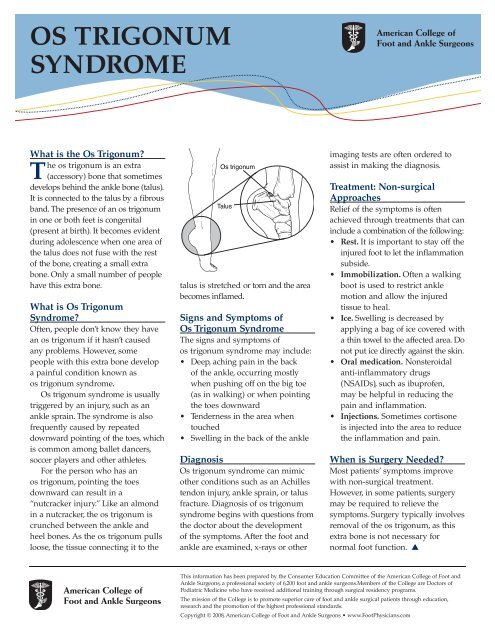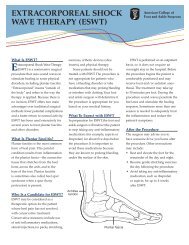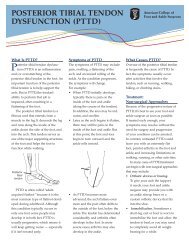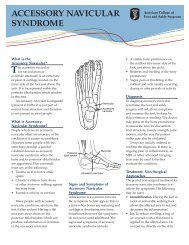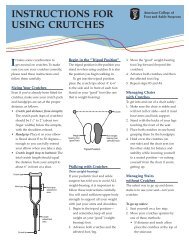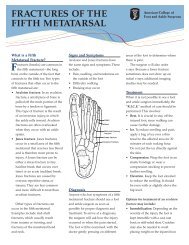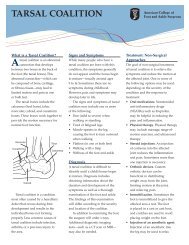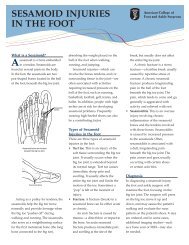OS TRIGONUM SYNDROME
OS TRIGONUM SYNDROME
OS TRIGONUM SYNDROME
Create successful ePaper yourself
Turn your PDF publications into a flip-book with our unique Google optimized e-Paper software.
<strong>OS</strong> <strong>TRIGONUM</strong><strong>SYNDROME</strong>What is the Os Trigonum?The os trigonum is an extra(accessory) bone that sometimesdevelops behind the ankle bone (talus).It is connected to the talus by a fibrousband. The presence of an os trigonumin one or both feet is congenital(present at birth). It becomes evidentduring adolescence when one area ofthe talus does not fuse with the restof the bone, creating a small extrabone. Only a small number of peoplehave this extra bone.What is Os TrigonumSyndrome?Often, people don’t know they havean os trigonum if it hasn’t causedany problems. However, somepeople with this extra bone developa painful condition known asos trigonum syndrome.Os trigonum syndrome is usuallytriggered by an injury, such as anankle sprain. The syndrome is alsofrequently caused by repeateddownward pointing of the toes, whichis common among ballet dancers,soccer players and other athletes.For the person who has anos trigonum, pointing the toesdownward can result in a“nutcracker injury.” Like an almondin a nutcracker, the os trigonum iscrunched between the ankle andheel bones. As the os trigonum pullsloose, the tissue connecting it to theOs trigonumTalustalus is stretched or torn and the areabecomes inflamed.Signs and Symptoms ofOs Trigonum SyndromeThe signs and symptoms ofos trigonum syndrome may include:• Deep, aching pain in the backof the ankle, occurring mostlywhen pushing off on the big toe(as in walking) or when pointingthe toes downward• Tenderness in the area whentouched• Swelling in the back of the ankleDiagnosisOs trigonum syndrome can mimicother conditions such as an Achillestendon injury, ankle sprain, or talusfracture. Diagnosis of os trigonumsyndrome begins with questions fromthe doctor about the developmentof the symptoms. After the foot andankle are examined, x-rays or otherimaging tests are often ordered toassist in making the diagnosis.Treatment: Non-surgicalApproachesRelief of the symptoms is oftenachieved through treatments that caninclude a combination of the following:• Rest. It is important to stay off theinjured foot to let the inflammationsubside.• Immobilization. Often a walkingboot is used to restrict anklemotion and allow the injuredtissue to heal.• Ice. Swelling is decreased byapplying a bag of ice covered witha thin towel to the affected area. Donot put ice directly against the skin.• Oral medication. Nonsteroidalanti-inflammatory drugs(NSAIDs), such as ibuprofen,may be helpful in reducing thepain and inflammation.• Injections. Sometimes cortisoneis injected into the area to reducethe inflammation and pain.When is Surgery Needed?Most patients’ symptoms improvewith non-surgical treatment.However, in some patients, surgerymay be required to relieve thesymptoms. Surgery typically involvesremoval of the os trigonum, as thisextra bone is not necessary fornormal foot function. ▲This information has been prepared by the Consumer Education Committee of the American College of Foot andAnkle Surgeons, a professional society of 6,200 foot and ankle surgeons.Members of the College are Doctors ofPodiatric Medicine who have received additional training through surgical residency programs.The mission of the College is to promote superior care of foot and ankle surgical patients through education,research and the promotion of the highest professional standards.Copyright © 2008, American College of Foot and Ankle Surgeons • www.FootPhysicians.com


